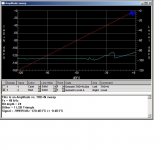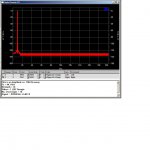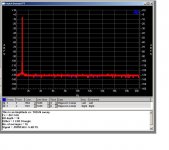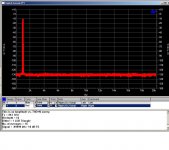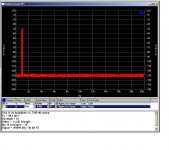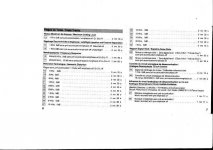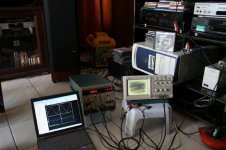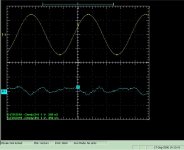rfbrw said:
PS. Now I think about it, there is something that can be done, that would allow one to exceed 0dBFS in a number cases but I am not so sure it is worth the effort, especially if you cannot build it yourself.
Well?
Cheers George
Hi George, I made some plots. I made these on an old Ap (System One). It's not very fancy as far as it's digital capabilities, yet it shows excellent performance at -0 dB FS. This makes the mystery deeper for me. When you made those scope shots (the great looking ones), did you monitor what the Quad's and the headphones were "seeing". In other words, were you right at the speaker teriminals?? I'm just wondering if there could have been some kind of input overload issue. I can't see the earlier posts from this page and I'm too lazy to re-type everything, but I remember something about 22V or so rails?? If those potentially large output levels aren't padded down, they might cause some input overload.
rfbrw said:
.....Hmmmmm. I'm not too sure about that. The overloaded signal in in the data, it isn't generated by the DAC. ....it is reproduced by the DAC. The only way that I see to remove the distortion components is to bandpass the fundamental. This would only be good if you waned to listen to 1 kHz all of the time. You might already be bored about that
Okay so I made some plots. The first plot is a digital amplitude vs. distortion sweep. I saw an interesting little bump at -30 dB FS but it looked really good at -5 ~ -0 dB FS.
rfbrw said:
PS. Now I think about it, there is something that can be done, that would allow one to exceed 0dBFS in a number cases but I am not so sure it is worth the effort, especially if you cannot build it yourself.
.....Hmmmmm. I'm not too sure about that. The overloaded signal in in the data, it isn't generated by the DAC. ....it is reproduced by the DAC. The only way that I see to remove the distortion components is to bandpass the fundamental. This would only be good if you waned to listen to 1 kHz all of the time. You might already be bored about that
Okay so I made some plots. The first plot is a digital amplitude vs. distortion sweep. I saw an interesting little bump at -30 dB FS but it looked really good at -5 ~ -0 dB FS.
Attachments
....and -30 dB FS
You talked about the best sounding CD's that you have had required large volume settings. Yeah, they're making good use of the 96 dB Dynamic range that CD's offer. Good for them. It sounds like they don't want to compress. Most pop and rock is very compressed, leaving a high average volume level. Your "quiet" CD's probably do get very close to full-scale, but use very little compression. Intermittent use of the full-scale output sounds the best to me. These dynamic recordings are the best ones to show off a good sound system.
You talked about the best sounding CD's that you have had required large volume settings. Yeah, they're making good use of the 96 dB Dynamic range that CD's offer. Good for them. It sounds like they don't want to compress. Most pop and rock is very compressed, leaving a high average volume level. Your "quiet" CD's probably do get very close to full-scale, but use very little compression. Intermittent use of the full-scale output sounds the best to me. These dynamic recordings are the best ones to show off a good sound system.
Attachments
As I said in a number of cases. You have to decide what the problem is. If the disc has clipped samples then there is nothing you can do. If, OTOH, the disc has been recorded close to the edge and there is a little gain in the digital signal path then you can attenuate the data digitally as has been done by someone else in the forum.
Hi guys,
Running a CD at a 0 Vu level was a standard test I did for years, but haven't lately. I have never run into this.
Another thing to check are the "0" crossings. FFT would catch that as well.
I might get a chance to look at the new Cyrus units today. I can even run those into some Audio Alchemy DAC boards I have lying around.
-Chris
Running a CD at a 0 Vu level was a standard test I did for years, but haven't lately. I have never run into this.
Another thing to check are the "0" crossings. FFT would catch that as well.
I might get a chance to look at the new Cyrus units today. I can even run those into some Audio Alchemy DAC boards I have lying around.
-Chris
mrshow4u said:...This is -0 dB FS 16-bit, 44.1 kHz to mimick a CD.
mrshow4u the bottom of the 1k spike at 0dfs has to step up in this pic where all the others -5 -10 and -15 don't have to step up as much? Is this some form of distortion, excuse my ignorance.
Cheers George
Hi georgehifi,
That's an artefact of the sampling process and the windowing used to truncate the signal for FFT'ing purpose.
The noise floors are similar in both plots, and more importantly, no other spikes show up in the whole band above 1KHz, up to 20KHz. This means essentially there isn't any distortion that the AP1 can pick up - at least nothing above -130dbfs...
That AP1 is a nice machine...
Cheers!
That's an artefact of the sampling process and the windowing used to truncate the signal for FFT'ing purpose.
The noise floors are similar in both plots, and more importantly, no other spikes show up in the whole band above 1KHz, up to 20KHz. This means essentially there isn't any distortion that the AP1 can pick up - at least nothing above -130dbfs...
That AP1 is a nice machine...
Cheers!
Hi George, any differences at the base of the fundamental's spike is not likeley wht your hearing. It's in the basement -120 -130 dB FS. I don't know what kind of DAC Audio Precision is using. It's 24 bit capable, but it's old too. The plots are old DAC performance. I think stuff available on consumer gear these days should be as good if not better than the Ap's DAC performance. I'm going to check to see if I have the Pierre Varney disc. I may, I have a couple of Sony and Philips test discs around. I don't think I have the Denon one though.
Hi George,
I just tried a vintage Luxman D-103 and a current Cyrus CD8. Neither of these machines displayed the defect you have witnessed. The THD residuals were predominately noise for the CD8 and second harmonic for the Luxman. That second harmonic looked pretty clean too!
Since the Cyrus is current, try and borrow one if you can. Home demo or some such.
-Chris
I just tried a vintage Luxman D-103 and a current Cyrus CD8. Neither of these machines displayed the defect you have witnessed. The THD residuals were predominately noise for the CD8 and second harmonic for the Luxman. That second harmonic looked pretty clean too!
Since the Cyrus is current, try and borrow one if you can. Home demo or some such.
-Chris
anatech said:Hi George,
I just tried a vintage Luxman D-103 and a current Cyrus CD8. Neither of these machines displayed the defect you have witnessed. The THD residuals were predominately noise for the CD8 and second harmonic for the Luxman. That second harmonic looked pretty clean too!
Since the Cyrus is current, try and borrow one if you can. Home demo or some such.
-Chris
Chris I take it from this that you were listening not measuring?
Cheers George
Hi George,
I listened to both in the same setup. I then ran each unit though my THD analyzer and had a good look at the residual on the scope.
The residuals were vastly different. The Cyrus was generally random noise whereas the Luman had a very clear second harmonic with some lower odd harmonic content. The Luxman measured about 1/2 the total THD and noise of the Cyrus. THe Luxman has an analog filter with three tuned inductors. This would be familiar to any "old" CD tech. I am sure this would cut much of the random noise I measured. I did not have the opportunity to run it into my computer for an FFT analysis.
I used track 13 on disc one of the Pierre Verany set. Track 14 is digital silence, so it wouldn't pin my meter. This would be a danger on other tracks where there is a full reference signal followed by other audio tracks.
-Chris
I listened to both in the same setup. I then ran each unit though my THD analyzer and had a good look at the residual on the scope.
The residuals were vastly different. The Cyrus was generally random noise whereas the Luman had a very clear second harmonic with some lower odd harmonic content. The Luxman measured about 1/2 the total THD and noise of the Cyrus. THe Luxman has an analog filter with three tuned inductors. This would be familiar to any "old" CD tech. I am sure this would cut much of the random noise I measured. I did not have the opportunity to run it into my computer for an FFT analysis.
I used track 13 on disc one of the Pierre Verany set. Track 14 is digital silence, so it wouldn't pin my meter. This would be a danger on other tracks where there is a full reference signal followed by other audio tracks.
-Chris
Hi George,
No. There should be no reason to do so. What you have described would be immediately obvious. Anything but a pure tone in the midrange is easy to pick out. I do this on a regular basis when testing amplifiers and speakers. I did this quite a lot when doing warranty for various speaker brands.
I will however try this later. It will have to be on Monday. I can't do this any sooner.
One thought. Is it possible your input on the preamp is misbehaving? Many use IC's to switch sources.
-Chris
No. There should be no reason to do so. What you have described would be immediately obvious. Anything but a pure tone in the midrange is easy to pick out. I do this on a regular basis when testing amplifiers and speakers. I did this quite a lot when doing warranty for various speaker brands.
I will however try this later. It will have to be on Monday. I can't do this any sooner.
One thought. Is it possible your input on the preamp is misbehaving? Many use IC's to switch sources.
-Chris
anatech said:Hi George,
No. There should be no reason to do so. What you have described would be immediately obvious. Anything but a pure tone in the midrange is easy to pick out. I do this on a regular basis when testing amplifiers and speakers. I did this quite a lot when doing warranty for various speaker brands.
I will however try this later. It will have to be on Monday. I can't do this any sooner.
One thought. Is it possible your input on the preamp is misbehaving? Many use IC's to switch sources.
-Chris
Passive pre!
This is where your hearing thinks the 0dfs sounds ok, like I said it's slight, but definatly there, when you go from hearing -10dfs then listen to 0dfs.
I even experimented with my mate who owns the Meridian G08 and he thought the 0dfs souned fine at first then I played the -10dfs and then went back to the 0dfs and only then he heard it definatly.
Like I said it's only a slight overtone, unless you hear it pure first it's hard to pick.
Cheers George
I don't have any decent headphones, but here's the setup I used:
Player: Sony CDP-X33ES (single-bit)
Disk: Denon Hi-Fi Sound Check (Track 39 - 0dbfs, 997Hz)
Distortion Analyzer: Tektronix AA5001 on a 5003 frame
'Scope: Tek TDS-210, set to average 16x on each channel
Capture of distortion/main waveform done via TCM on the TDS-210 and the Wavestar software.
Result: Distortion at 0dbfs is below the noise floor of the AA5001 (0.0024%, as can be seen in the pic attached).
Player: Sony CDP-X33ES (single-bit)
Disk: Denon Hi-Fi Sound Check (Track 39 - 0dbfs, 997Hz)
Distortion Analyzer: Tektronix AA5001 on a 5003 frame
'Scope: Tek TDS-210, set to average 16x on each channel
Capture of distortion/main waveform done via TCM on the TDS-210 and the Wavestar software.
Result: Distortion at 0dbfs is below the noise floor of the AA5001 (0.0024%, as can be seen in the pic attached).
Attachments
- Status
- This old topic is closed. If you want to reopen this topic, contact a moderator using the "Report Post" button.
- Home
- Source & Line
- Digital Source
- Can over loud cd's overload dacs ? (Jocko?)
